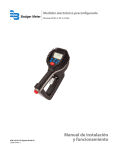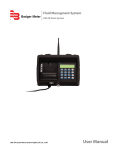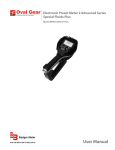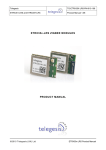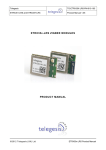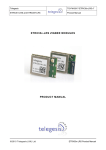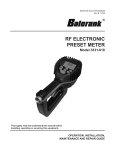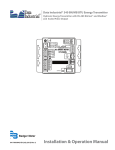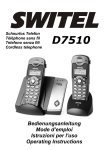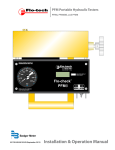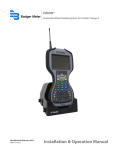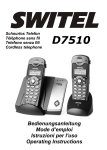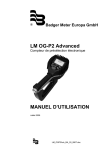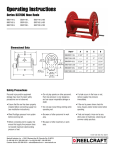Download Spec Sheet - Western Environmental Canada
Transcript
Electronic Preset Meter Model EPM-3, RF 2.4 GHz IOM-197-02-EN (November 2012) 53400-197 Rev. 2 Installation & Operation Manual Electronic Preset Meter Model EPM-3, RF 2.4 GHz Page ii November 2012 Installation & Operation Manual CONTENTS SAFETY . . . . . . . . . . . . . . . . . . . . . . . . . . . . . . . . . . . . . . . . . . . . . . . . . . . . . . . . . . . . . .5 Explosion and Fire Hazards . . . . . . . . . . . . . . . . . . . . . . . . . . . . . . . . . . . . . . . . . . . . . . . . 5 Meter Hazards . . . . . . . . . . . . . . . . . . . . . . . . . . . . . . . . . . . . . . . . . . . . . . . . . . . . . . . . 5 ELECTRONIC PRESET METER DESCRIPTION . . . . . . . . . . . . . . . . . . . . . . . . . . . . . . . . . . . . . . 6 Disclaimer . . . . . . . . . . . . . . . . . . . . . . . . . . . . . . . . . . . . . . . . . . . . . . . . . . . . . . . . . . 6 Product Identification Information . . . . . . . . . . . . . . . . . . . . . . . . . . . . . . . . . . . . . . . . . . . 6 Certification . . . . . . . . . . . . . . . . . . . . . . . . . . . . . . . . . . . . . . . . . . . . . . . . . . . . . . . . . 6 OPERATION . . . . . . . . . . . . . . . . . . . . . . . . . . . . . . . . . . . . . . . . . . . . . . . . . . . . . . . . . . . 7 Meter Buttons . . . . . . . . . . . . . . . . . . . . . . . . . . . . . . . . . . . . . . . . . . . . . . . . . . . . . . . . 7 LCD Display . . . . . . . . . . . . . . . . . . . . . . . . . . . . . . . . . . . . . . . . . . . . . . . . . . . . . . . . . 7 METER INSTALLATION . . . . . . . . . . . . . . . . . . . . . . . . . . . . . . . . . . . . . . . . . . . . . . . . . . . . 8 Relieve System Pressure . . . . . . . . . . . . . . . . . . . . . . . . . . . . . . . . . . . . . . . . . . . . . . . . . 8 Grounding . . . . . . . . . . . . . . . . . . . . . . . . . . . . . . . . . . . . . . . . . . . . . . . . . . . . . . . . . . 8 Flushing Procedure . . . . . . . . . . . . . . . . . . . . . . . . . . . . . . . . . . . . . . . . . . . . . . . . . . . . 8 Apply Meter to Hose . . . . . . . . . . . . . . . . . . . . . . . . . . . . . . . . . . . . . . . . . . . . . . . . . . . . 9 Apply Nozzle to Meter . . . . . . . . . . . . . . . . . . . . . . . . . . . . . . . . . . . . . . . . . . . . . . . . . . . 9 METER OPERATION, RF MODE . . . . . . . . . . . . . . . . . . . . . . . . . . . . . . . . . . . . . . . . . . . . . . 10 Connecting to an FMS Network . . . . . . . . . . . . . . . . . . . . . . . . . . . . . . . . . . . . . . . . . . . . 10 History Icon . . . . . . . . . . . . . . . . . . . . . . . . . . . . . . . . . . . . . . . . . . . . . . . . . . . . . . . . 11 Error Codes . . . . . . . . . . . . . . . . . . . . . . . . . . . . . . . . . . . . . . . . . . . . . . . . . . . . . . . . . 11 METER OPERATION, EPM MODE . . . . . . . . . . . . . . . . . . . . . . . . . . . . . . . . . . . . . . . . . . . . 12 EPM Manual Mode . . . . . . . . . . . . . . . . . . . . . . . . . . . . . . . . . . . . . . . . . . . . . . . . . . . . 12 EPM Batch Mode . . . . . . . . . . . . . . . . . . . . . . . . . . . . . . . . . . . . . . . . . . . . . . . . . . . . . 12 Return to RF Mode . . . . . . . . . . . . . . . . . . . . . . . . . . . . . . . . . . . . . . . . . . . . . . . . . . . . 13 OPERATING MODE FUNCTIONS . . . . . . . . . . . . . . . . . . . . . . . . . . . . . . . . . . . . . . . . . . . . . 14 Resettable/Accumulated Totals . . . . . . . . . . . . . . . . . . . . . . . . . . . . . . . . . . . . . . . . . . . . 14 Emergency Override . . . . . . . . . . . . . . . . . . . . . . . . . . . . . . . . . . . . . . . . . . . . . . . . . . . 14 CALCULATING THE SCALE FACTOR . . . . . . . . . . . . . . . . . . . . . . . . . . . . . . . . . . . . . . . . . . . 15 Viewing the Current Scale Factor . . . . . . . . . . . . . . . . . . . . . . . . . . . . . . . . . . . . . . . . . . . 15 Absolute Scale Factor . . . . . . . . . . . . . . . . . . . . . . . . . . . . . . . . . . . . . . . . . . . . . . . . . . 15 CHANGING FACTORY SETTINGS . . . . . . . . . . . . . . . . . . . . . . . . . . . . . . . . . . . . . . . . . . . . 17 Verifying Firmware Version . . . . . . . . . . . . . . . . . . . . . . . . . . . . . . . . . . . . . . . . . . . . . . . 17 Using the Programming Feature . . . . . . . . . . . . . . . . . . . . . . . . . . . . . . . . . . . . . . . . . . . 17 Changing the Unit of Measure . . . . . . . . . . . . . . . . . . . . . . . . . . . . . . . . . . . . . . . . . . . . 17 Changing the Scale Factor . . . . . . . . . . . . . . . . . . . . . . . . . . . . . . . . . . . . . . . . . . . . . . . 18 Verifying Changes . . . . . . . . . . . . . . . . . . . . . . . . . . . . . . . . . . . . . . . . . . . . . . . . . . . . 18 Enabling or Disabling the EPM (Manual) Mode . . . . . . . . . . . . . . . . . . . . . . . . . . . . . . . . . . 18 Network Program . . . . . . . . . . . . . . . . . . . . . . . . . . . . . . . . . . . . . . . . . . . . . . . . . . . . 19 Power Level Display . . . . . . . . . . . . . . . . . . . . . . . . . . . . . . . . . . . . . . . . . . . . . . . . . . . 19 November 2012 Page iii Electronic Preset Meter Model EPM-3, RF 2.4 GHz DIMENSIONS . . . . . . . . . . . . . . . . . . . . . . . . . . . . . . . . . . . . . . . . . . . . . . . . . . . . . . . . . 20 SPECIFICATIONS . . . . . . . . . . . . . . . . . . . . . . . . . . . . . . . . . . . . . . . . . . . . . . . . . . . . . . . 20 PARTS LIST . . . . . . . . . . . . . . . . . . . . . . . . . . . . . . . . . . . . . . . . . . . . . . . . . . . . . . . . . . 21 TROUBLESHOOTING . . . . . . . . . . . . . . . . . . . . . . . . . . . . . . . . . . . . . . . . . . . . . . . . . . . . 24 MAINTENANCE . . . . . . . . . . . . . . . . . . . . . . . . . . . . . . . . . . . . . . . . . . . . . . . . . . . . . . . 25 Low Battery Indicators . . . . . . . . . . . . . . . . . . . . . . . . . . . . . . . . . . . . . . . . . . . . . . . . . 25 Changing the Batteries . . . . . . . . . . . . . . . . . . . . . . . . . . . . . . . . . . . . . . . . . . . . . . . . . 25 Page iv November 2012 Installation & Operation Manual SAFETY Explosion and Fire Hazards Improper grounding, poor ventilation, open flames or sparks can cause a hazardous condition and result in an explosion or fire and cause serious injury. • Be sure the fluid system is properly grounded. See your pump instruction manual for details. • If there is static sparking or if you feel an electric shock while using the meter, stop dispensing immediately. Identify and correct the problem before continuing. • Provide fresh air ventilation. This will avoid the buildup of fumes from the fluid being dispensed. • Do not smoke while dispensing flammable fluids. • Keep the dispensing area free of debris including solvents, rags and spilled gasoline. Meter Hazards Equipment misuse can cause the meter to rupture or malfunction and cause serious injury. • This equipment is for professional use only. • Read all instructions, tags and labels before operating the equipment. • Use the equipment only for its intended purpose. • Do NOT modify or alter the equipment. • Do NOT leave equipment unattended while dispensing. • Check equipment daily. Repair or replace worn or damaged parts immediately. • Do NOT exceed the maximum working pressure level of the lowest rated system component. • Use only extensions and nozzles that are designed for use with this equipment. • Use only fluids and solvents that are compatible with the equipment. Read all fluid and solvent manufacturer’s warnings. • Tighten all fluid connections before operating this equipment. • Do NOT stop or deflect leaks with hands, body, gloves or rags. • Do NOT dispense towards any person or any part of the body. • Do NOT place hands or fingers over the end of or into the dispense valve. • Comply with all local, state, and federal fire, electrical and safety regulations. • Use of this product in a manner other than specified in this manual may result in impaired operation or damage to equipment. November 2012 Page 5 Electronic Preset Meter Model EPM-3, RF 2.4 GHz ELECTRONIC PRESET METER DESCRIPTION Disclaimer The user/purchaser is expected to read and understand the information provided in this manual, follow any listed Safety Precautions and Instructions and keep this manual with the equipment for future reference. The information in this manual has been carefully checked and is believed to be entirely reliable and consistent with the product described. However, no responsibility is assumed for inaccuracies, nor does Badger Meter Inc. assume any liability arising out of the application and use of the equipment described. Product Identification Information Record the product identification numbers from the nameplate here. Model Number _______ Serial Number _______ Tag Number _______(if applicable) Certification • • • • Contains FCC ID: S4GEM35XB Contains IC: 8735A-EM35XB FCC CERTIFIED, PART 15, SUB-PART C CE0681 EC-R&TTE Certified This device complies with Part 15 of the FCC Rules. Operation is subject to the following two conditions: (1) this device may not cause harmful interference, and (2) this device must accept any interference received, including interference that may cause undesired operation. To satisfy FCC RF exposure requirements for mobile transmitting devices, a separation distance of 20 cm or more should be maintained between the antenna of this device and persons during operation. To ensure compliance, operations at closer distances than this are not recommended. Page 6 November 2012 Installation & Operation Manual OPERATION The Electronic Preset Meter RF3 (EPM RF3) is equipped with RF (radio frequency) communications to communicate with a fluid management system keypad to get authorization and dispense information. This is referred to in the manual as the RF Mode. The meter can also be run as a standard EPM. This is referred to in the manual as the EPM Mode. This is intended for start-up purposes or when the fluid management system is not in use. Once a work order has been entered at the keypad, the operator simply pushes the RESET button on the meter to start communications between the meter and the keypad. The meter receives authorization from the keypad to unlock and the dispense batch quantity. When the trigger is pulled the preset dispense batch quantity dispenses. The meter automatically shuts off when the dispense batch quantity has been reached. A Topoff feature allows additional fluid to be dispensed and tracked after the batch quantity has been dispensed. Upon completion of the dispense, the operator presses the RESET button. The meter then locks, prohibiting any unauthorized dispense of fluid to occur, and the dispense quantity is sent to the keypad. Meter Buttons 10, 1, 0.1 TOTAL AUTO RESET SHUTOFF or STOP Used to enter the dispense Batch quantity when in the EPM Mode. These buttons are NOT used in RF Mode. Used to display the accumulated total of fluid dispensed, as well as the re-settable total. Used to enter and exit the manual or batch mode when in EPM mode. This button is NOT used in RF mode. • Used to initiate RF communications from the meter to the Keypad. • Used in EPM mode to clear the previous batch. • Used to reset the re-settable total dispensed while pressing the TOTAL button. Used to stop the flow through an Emergency Override. LCD Display 2 1 7 November 2012 6 5 4 3 1 Displays resettable total, accumulated total and scale factor 2 Displays unit of measure 3 Arrows flash when RF communication is in progress with the keypad 4 Preset Batch quantity 5 History Icon 6 AUTO is an indicator of being in EPM mode 7 Low Battery Icon Page 7 Electronic Preset Meter Model EPM-3, RF 2.4 GHz METER INSTALLATION Relieve System Pressure 1. Turn off the power supply to the pump or close the shutoff valve. 2. Dispense any fluid in the system into a waste container by opening the meter(s). 3. Open all bleed-type master air valves and fluid meter(s) in the system. 4. Leave the meter(s) open until ready to pressurize the system. Pressurized Equipment This equipment stays pressurized until the pressure is manually relieved. To reduce the risk of injury from fluid spray from the meter follow the Pressure Relief Procedures when you: • Are instructed to relieve pressure • Stop dispensing • Check, clean, or service any system equipment • Clean or install nozzles Grounding Grounding reduces the risk of static sparking. Ground all system components according to local, state, and federal codes. Consult the pump user's manual and other system components to ground the following: • Pump: follow manufacturer's recommendations • Air and Fluid Hoses: use only grounded hoses • Air Compressor: follow manufacturers recommendations • Fluid Supply Container: follow the local code Possible Explosion and Fire Movement of fluids through the dispensing system creates static electricity. Static electricity can cause volatile fumes resulting in an explosion and fire. The dispensing system must be grounded. Flushing Procedure NNOTE: If the system has multiple dispense positions, begin at the position farthest from the pump and move towards the pump. If this installation is new or if the fluid in the lines is contaminated, flush the system before installing the meter(s). 1. Close fluid dispense valves at every position. 2. Once the main fluid outlet valve at the pump is closed, the air pressure to the pump motor is properly adjusted and the air valve is opened. 3. Slowly open the main fluid valve. 4. Place the hose end in a waste container. Make sure hose is secure so no fluid leaks during flushing. 5. Slowly open the dispense valve and allow enough oil to pass through it to ensure that the system is clean. 6. Close the valve and repeat for all dispense positions. Page 8 November 2012 Installation & Operation Manual Apply Meter to Hose Close the drain valve before starting this procedure. 1. Attach a swivel to the meter. Apply thread sealant to the male end of hose. Recommended sealant is Loctite® 243. 2. Insert the metal end of the hose into the swivel. Tighten completely with an open ended, adjustable, wrench. NNOTE: The threaded end of the meter always has female threads. The metal end of the hose must have male threads. Apply thread sealant, Loctite® 243, or equivalent, to the male end. The inlet and outlet swivel connections are either 1/2" NPT or 1/2" BSPP, depending on meter model. Apply Nozzle to Meter 1. On the opposite end, apply sealant to the end of the nozzle. Recommended sealant is Loctite® 243. 2. Thread the nozzle onto the meter. Screw it in tightly with an open ended, adjustable, wrench. 3. Open all dispense position shut-off valves. Start the pump to pressurize the system. 4. Before use, to ensure accuracy, purge all air from the fluid lines and dispense valve(s). November 2012 Page 9 Electronic Preset Meter Model EPM-3, RF 2.4 GHz METER OPERATION, RF MODE Connecting to an FMS Network When the meter is first installed, it must be attached to the network with the keypad powered ON. Also, when the keypad is replaced, the meter must be reconnected. 1. Press and hold the 10 key. 2. While holding down the 10 key, press and release the RESET button. The meter will then search for and connect to the network. When the battery pack is attached to the meter, it automatically enters the RF Mode. The trigger is in the locked-out position. No fluid can be dispensed by the meter until a dispense order is received from the keypad. 1. Pressing the meter RESET button causes communication to occur between the meter and the keypad. Two arrows in the lower right hand corner of the meter screen flash. This indicates communication is in progress between the meter and keypad. Arrows 2. When the communication is complete the trigger unlocks and the batch quantity is displayed. Batch Quantity 3. Pull the trigger to the full, up, position to begin the fluid flow. • The solenoid valve automatically locks the dispensing valve in the full open position. The trigger falls back to the closed position. • It is not necessary to continue to hold the trigger. • After the batch quantity is dispensed, the flow automatically shuts off. Do NOT press the RESET button before topping off. If the RESET button is pressed, the meter returns to a locked-out position and does not allow additional fluid to be dispensed until a valid dispense order is received from the RF system. 4. You have the option to top off the tank after the batch quantity has been dispensed. a. To top off, pull the trigger to begin the flow. b. Release the trigger when the desired amount has been dispensed. 5. Press the RESET button when finished to complete the dispense order. a. The total quantity dispensed is transmitted to the RF system. b. The meter returns to the locked position. c. The meter is now ready to receive another dispense order from the RF system. NNOTE: If the original communication fails, the meter automatically attempts to communicate with the RF system by resending the Dispense Result three times, 30 seconds apart. 6. If the meter is unable to communicate a dispense result, the History icon lights. Page 10 November 2012 Installation & Operation Manual History Icon The History icon indicates there is dispense result information that has not been communicated to the keypad to complete a work order. To send the dispense result information to the keypad, press the RESET button to initiate communication. History Icon Error Codes The meter has several Error Codes that may display. These provide indication, at the meter, that there is an error in communication between the meter and keypad. F01 The meter radio is not working. To clear the error, press the RESET button on the meter. F02 The meter is not configured to a keypad. To clear the error code, press the RESET button on the meter. Verify that the meter radio address is configured properly. F03 System busy. To clear the error, press the RESET button on the meter. F08 Meter lost connection to network. Out of range—network connection lost. Keypad not powered. Meter moved out of range of keypad. F09 Meter not connected to a network. First time being powered up. Network selected is not available. SF0 (Scale Factor 0) The Scale Factor setting for the meter is set to 0.000. All other Error Codes Are for factory purposes only. November 2012 To input a valid Scale Factor for the meter follow the instructions in the Change Factory Settings section of this manual. To clear the meter, press RESET. Page 11 Electronic Preset Meter Model EPM-3, RF 2.4 GHz METER OPERATION, EPM MODE The meter can be put in EPM Mode for startup purposes by entering the Manual Mode key sequence. Consult the factory for the sequence. The AUTO icon displays, indicating the meter is in the EPM Mode. The solenoid valve unlocks and the meter can now be used as a Standard Preset Batch Meter. NNOTE: The AUTO button is used to toggle between Manual Mode and Batch Mode. EPM Manual Mode 1. Pull the trigger to begin the flow. 2. The display shows the amount dispensed. 3. When the desired amount has been dispensed, release the trigger to stop the flow. 4. Press the RESET button once to reset the counter display to zero. Amount Dispensed EPM Batch Mode To enter the Batch Mode from the Manual Mode, press the AUTO button. When in the Batch Mode, the batch quantity displays in the lower right-hand corner of the screen. The meter is now in Batch Mode. Batch Quantity 1. Change the batch size by pressing the 10, 1 and/or 0.1 buttons. a. Press the 10 button to increase the batch amount in increments of 10 units. b. Press the 1 button to increase the batch amount in increments of 1 unit. c. Press the 0.1 button to increase the batch amount in increments of 0.1 units. 2. Pull the trigger to begin the flow. Batch Size The meter solenoid valve automatically locks the dispensing valve in the full open position. The trigger falls back to the closed position. The meter always locks in the maximum open position. After the batch quantity is dispensed, the flow automatically shuts off. NNOTE: For RF and BATCH programming, the meter automatically shuts off if the trigger is pulled and the meter does not sense any flow. Also, in case of an emergency or to interrupt a batch, the meter is equipped with an Emergency Override. (Refer to the "Emergency Override" on page 14 section of this manual.) Page 12 November 2012 Installation & Operation Manual Return to RF Mode To return to the RF Mode from the EPM Mode: 1. If the batch quantity on the display is not zero, press the RESET button to zero the display. 2. Press the RESET button with a zero batch quantity on the display. You’ll see the flashing arrows indicating the meter is communicating with the RF System. Arrows 3. When communication is complete, the meter returns to the RF Mode and the trigger locks. To manually reset the meter to the RF Mode: 1. If the batch quantity on the display is not zero, press the RESET button to zero the display 2. Re-enter the Manual Mode key sequence. November 2012 Page 13 Electronic Preset Meter Model EPM-3, RF 2.4 GHz OPERATING MODE FUNCTIONS These functions operate the same in RF Mode and EPM Mode. Resettable/Accumulated Totals The meter has two flow totalizers. One is Resettable Total the other is Accumulated Total. 1. Press and hold the TOTAL button to see the Accumulated Total. 2. Continue holding the TOTAL button for three seconds to see the Resettable Total. RESETTOTAL displays the total fluid dispensed since the Resettable Total was last set back to zero. 3. Press the RESET button while viewing RESETTOTAL to set it back to zero. Resettable Total 4. Release the TOTAL button to return to the operating display. NNOTE: The Accumulated Total cannot be reset unless the you change the unit setting from English units to metric units or from metric to English units. (Refer to the Change Factory Settings, Change Unit of Measure section of this manual). Emergency Override In case of an emergency or to interrupt a batch, the meter is equipped with an Emergency Override. 1. Press the red O button to activate the Emergency Override. The override closes the valve, immediately stopping fluid flow. 2. Batching can continue after an Emergency Override by pulling up on the trigger. Page 14 November 2012 Installation & Operation Manual CALCULATING THE SCALE FACTOR A Scale Factor is a number used to adjust meter accuracy. The Scale Factor is set at the factory using motor oil with a viscosity of 10W. The primary use for Scale Factor recalibration is to batch fluids with different viscosities. If the fluid has a lower viscosity, more fluid can slip past the meter gears without being detected. Changing the Scale Factor adjusts the meter to compensate for the loss. The meter multiplies each pulse by the Scale Factor number to correct the accuracy when it converts to the specified units. The reading is then always correct. For an approximate Scale Factor for fluids of different viscosities, consult the charts on the next page. NNOTE: The meter’s original Scale Factor was written on the trigger when it was calibrated at the factory. It may have been revised after field installation. Use the Scale Factor showing on the display, not the one written on the trigger. IMPORTANT Changing the Scale Factor changes the accuracy of the meter, potentially causing over-dispensing or under-dispensing of the liquid. Viewing the Current Scale Factor To view the current Scale Factor, press and hold the TOTAL button and the AUTO button at the same time. Absolute Scale Factor For absolute Scale Factor, perform this test: 1. Run a measured amount of fluid through the meter. 2. If the meter delivers 4.20 quarts and the display shows only 4.00 quarts, then the Scale Factor needs to be adjusted. 3. Divide what the meter delivered (4.20) by what the display shows (4.00). You get an error factor of (1.05). The existing Scale Factor is 1.0123. 4. To calculate a new factor: 1.0123 (existing Scale Factor) x 1.05 (error factor) = 1.0629 (new Scale Factor). 5. Enter that number as described in the Change Scale Factor section of this manual. NNOTE: Use the Scale Factor showing on the display, not one written on the trigger. November 2012 Page 15 Electronic Preset Meter Model EPM-3, RF 2.4 GHz Figure 6: Chart of Approximate Scale Factors for Fluids of Different Viscosities Fluid Viscosity Scale Factor Water/Anti-Freeze 5 1.044 Anti-Freeze 18 1.007 Brake Fluid 42 1.004 ATF 80 1.002 10W 140 1.000 80W-90 450 0.999 140W 1800 0.993 Table 2: Samples of Fluids, Viscosities and Scale Factors Page 16 November 2012 Installation & Operation Manual CHANGING FACTORY SETTINGS Each meter is calibrated at the factory for use with motor oil (refer to the Change Scale Factor section of this manual). The Unit of Measure is also selected prior to shipment. Verifying Firmware Version To check the firmware version and code checksum, press and hold the TOTAL and 1 buttons at the same time. The last two digits on the lower right are the firmware version. Using the Programming Feature Use the Programming feature to change the factory settings: Push the AUTO and TOTAL buttons at the same time and hold for 2 seconds to bring up the Program PIN screen. To enter your PIN: 1. Press and hold the 10 button to select first digit of PIN. 2. Press and hold the 1 button to select second digit of PIN. 3. Press and hold the 0.1 button to select third digit of PIN. 4. If necessary, hold down the TOTAL key and press 10, 1, or 0.1 to decrement a PIN digit. 5. Press RESET to confirm PIN and enter the programming mode with Scale Factor and Unit of Measure screen displayed. 6. Push and hold AUTO and TOTAL for 2 seconds to exit the programming mode. Changing the Unit of Measure The meter has four Units of Measure: • Pint (PT) • Quart (QT) • Gallon (GAL) • Liter (L) Changing the Unit of Measure from metric to English or from English to metric clears the Resettable Total and the Accumulated Total. The current Unit of Measure is flashing when you enter the Programming Mode. To change the Unit of Measure: 1. Press and hold the TOTAL button until the Unit of Measure you want is displayed. 2. Press the RESET button to save your selection. 3. If you select L (Liters), the decimal point begins to flash. Press the TOTAL button to change the decimal point to either a period or a comma. 4. If no Scale Factor changes are necessary, press and hold the TOTAL and AUTO buttons until the display flashes three times, then goes blank OR Press the RESET button to advance to the EPM Manual Mode Enable screen. November 2012 Page 17 Electronic Preset Meter Model EPM-3, RF 2.4 GHz Changing the Scale Factor IMPORTANT Changing the Scale Factor changes the accuracy of the meter, potentially causing over-dispensing or under-dispensing of the liquid. This has the potential to cause a mechanical breakdown. Scale Factor Digits 1. Press the RESET button to advance through the Scale Factor digits. 2. Press the TOTAL button to change the selected number. NNOTE: All digits can be scrolled between 0 and 9 except the first. It can only be scrolled from 0 to 1 or from 1 to 0. Unit of Measure Scale Factor Digits 3. Press the RESET button advance to the next number in Scale Factor. 4. Repeat steps 2 and 3 for all five digits in Scale Factor. 5. If no Scale Factor changes are necessary, press and hold the TOTAL and AUTO buttons until the display flashes three times, then goes blank OR Press the RESET button to advance to the EPM Manual Mode Enable screen. Verifying Changes Press and hold down the TOTAL and AUTO buttons at the same time to verify that the Scale Factor is correct. Enabling or Disabling the EPM (Manual) Mode To enable or disable the EPM mode: 1. Press the RESET button to advance to the AUTO icon on the display. There will be no other icons flashing on the display. 2. Press the AUTO button to toggle the AUTO icon on and off. When the icon is turned on the meter can be put in EPM mode through the special key sequence on the meter keypad. When the AUTO icon is turned off the key sequence is disabled and the meter cannot be put in EPM mode. 3. Press the RESET button to advance to the Network Program screen. . Page 18 November 2012 Installation & Operation Manual Network Program The Radio Network is used to differentiate multiple FMS networks. For standard installations the default setting of zero will not need to be changed. The Network setting must be between 0 and 255. To change the network setting: 1. Press 1 to increment network setting or press 0.1 to decrement network setting. 2. Press RESET to advance to the Power Level Display screen. NNOTE: When NOT in programming mode, you can view the Radio Network by holding down the TOTAL button while pressing the 10 button. Power Level Display 1. The radio power level is set at the factory. The display is for validation purposes only. 2. Press RESET to return to Scale Factor and Unit of Measure screen. NNOTE: When NOT in programming mode, you can view the Power Level by holding down the TOTAL button while pressing the 1 button. Saving Changes To save your changes and exit the programming mode: 1. Press and hold down the TOTAL and AUTO buttons at the same time. The display will flash 3 times and go blank. 2. Press the RESET button to turn on the display. November 2012 Page 19 Electronic Preset Meter Model EPM-3, RF 2.4 GHz DIMENSIONS SPECIFICATIONS Maximum Flow * 10 gpm (38 lpm) Minimum Flow * 0.25 gpm (1 lpm) Operating Pressure (Maximum) 1000 psi (67 bar) Operating Pressure (Minimum) 5 psi (0.35 bar) Operating Temperature (Maximum) 120° F (50° C) Operating Temperature (Minimum) 20° F (–5° C) Accuracy – Oils +/– 0.5% (+/– 0.5%) Accuracy – Anti-freeze +/– 1.5% (+/– 1.5%) 5-Digit LCD Display, 10 mm high x 5 mm wide Quarts (liters), pints, gallons Inlet and Outlet Connections 1/2" NPT (1/2" BSPP) * Tested with DTE-25 motor oil at ambient temperature. Minimum/maximum flow range will vary with fluid viscosity. Page 20 November 2012 Installation & Operation Manual PARTS LIST November 2012 Item # Description Part Number 1 Battery holder assembly 64103-026 2 Bottom case with screws and radio 64103-029 3 Solenoid 64786-002 Page 21 Electronic Preset Meter Model EPM-3, RF 2.4 GHz 1 2 3 Page 22 Item # Description Part Number 1 Rubber boot 65546-001 2 Display assembly 64103-023 3 RF register assembly 64103-030 Not Shown Swivel, NPT AFLAS 64082-007 November 2012 Installation & Operation Manual 2 1 3 November 2012 Item # Description Part Number 1 Valve assembly – AFLAS 64103-020 2 LCP gear set with AFLAS o-ring 62896-003 3 Trigger assembly 64103-015 Page 23 Electronic Preset Meter Model EPM-3, RF 2.4 GHz TROUBLESHOOTING Pressurized Equipment Relieve the pressure prior to checking or repairing the meter. Make sure all valves, controls and pumps are operating correctly. Symptom Possible Cause Remedy Battery Icon is displayed Batteries are low Replace batteries Display Blank Meter asleep Press RESET button Loose battery connection • Remove battery pack and check battery connection • Press RESET button Batteries dead • Replace batteries • Press RESET button Meter not in AUTO mode Press AUTO button and program batch size Meter not reset after prior batch Press RESET button Low batteries • Check for battery icon • Replace batteries • Press RESET button Filter is clogged Clean or replace the filter in the swivel nut Pump pressure is low Turn up the pump pressure Foreign material is jamming meter Contact your local distributor for repair Scale factor not correct for fluid Enter program mode, check and reset program factor Meter does not latch for batching Slow or no fluid flow Meter inaccurate Page 24 November 2012 Installation & Operation Manual MAINTENANCE Low Battery Indicators When the batteries need changing, a progression of warnings appears on the meter screen. First Warning The Low Battery icon appears in the lower left corner of the display. That means the batteries are low and need to be changed when the icon appears. Second Warning The Battery icon flashes. The battery power is too low and meter functions are disabled. Low Battery Icon Changing the Batteries The battery compartment is located in the lower case on the backside of the trigger guard. 1. Position the unit face down. 2. Unscrew the two screws. Remove the battery door to expose the batteries. 3. Replace the old batteries with 4 AA alkaline batteries. NNOTE: Battery polarity markings are inside battery compartment. 4. Dispose of used batteries properly, according to local regulations. NNOTE: Changing the batteries does not affect any of the programmed values or totals. November 2012 Page 25 Electronic Preset Meter Model EPM-3, RF 2.4 GHz INTENTIONAL BLANK PAGE Page 26 November 2012 Installation & Operation Manual INTENTIONAL BLANK PAGE November 2012 Page 27 Trademarks appearing in this document are the property of their respective entities. Due to continuous research, product improvements and enhancements, Badger Meter reserves the right to change product or system specifications without notice, except to the extent an outstanding contractual obligation exists. © 2012 Badger Meter, Inc. All rights reserved. www.badgermeter.com The Americas | Badger Meter | 4545 West Brown Deer Rd | PO Box 245036 | Milwaukee, WI 53224-9536 | 800-876-3837 | 414-355-0400 México | Badger Meter de las Americas, S.A. de C.V. | Pedro Luis Ogazón N°32 | Esq. Angelina N°24 | Colonia Guadalupe Inn | CP 01050 | México, DF | México | +52-55-5662-0882 Europe, Middle East and Africa | Badger Meter Europa GmbH | Nurtinger Str 76 | 72639 Neuffen | Germany | +49-7025-9208-0 Czech Republic | Badger Meter Czech Republic s.r.o. | Maříkova 2082/26 | 621 00 Brno, Czech Republic | +420-5-41420411 Slovakia | Badger Meter Slovakia s.r.o. | Racianska 109/B | 831 02 Bratislava, Slovakia | +421-2-44 63 83 01 Asia Pacific | Badger Meter | 80 Marine Parade Rd | 21-04 Parkway Parade | Singapore 449269 | +65-63464836 China | Badger Meter | Rm 501, N° 11 Longyue Apartment | N° 180 Longjin Rd, Jiuting Songjiang District | Shanghai, China | 201615 | +86-21-5763 5412




























